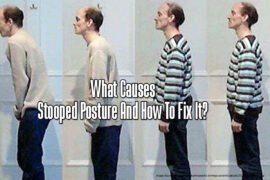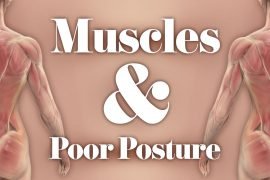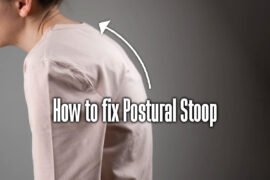What Is Text Neck Syndrome?
Table of Contents
Your muscles may have to work hard if you frequently look down at your phone or computer for hours because, depending on the angle, your head may weigh between 27 and 60 pounds. Text neck syndrome may cause tension or soreness in your neck.
Text neck syndrome is becoming a more significant problem, which is not surprising. Over time, it can cause spinal issues like pinched nerves and spinal deterioration.
Causes Of Text Neck Posture
Text neck posture is a condition caused by repeatedly tilting the head forward while using electronic devices such as smartphones, tablets, and laptops. The main causes of this posture include:
- Poor posture: Many people have poor posture when using electronic devices, which can cause strain on the neck and shoulders.
- Muscle imbalances: When the muscles in the neck and shoulders are not balanced, it can cause the head to tilt forward, leading to text neck posture.
- Weak muscles: Weak muscles in the neck and shoulders can cause the head to tilt forward, leading to text neck posture.
- Repetitive strain: Repeatedly looking down at electronic devices for extended periods may cause strain on the neck and shoulders, leading to text neck posture.
- Lack of breaks: Not taking enough breaks from using electronic devices can contribute to text neck posture, as it does not give the neck and shoulder muscles a chance to rest and recover.
- Overuse of electronic devices: Overuse of electronic devices can cause text neck posture, as it increases the amount of time spent in a posture that can strain the neck and shoulders.
Symptoms Of Text Neck Posture
Text neck posture, also known as “tech neck” or “forward head posture,” is a condition that can result from the prolonged use of handheld electronic devices, such as smartphones or tablets, and can cause various symptoms. Some common symptoms of text neck posture include:
- Pain in the neck and shoulders
- Stiffness or tightness in the neck and shoulders
- Headaches, especially in the back of the head
- Upper back pain and discomfort
- Reduced range of motion in the shoulders and neck
- Tingling or numbness in the arms, hands, and fingers
- Postural changes, including a rounded shoulder posture and a forward head position
- Fatigue or tiredness in the neck and shoulders, especially after prolonged device use
If left untreated, text neck posture can lead to chronic pain and discomfort, as well as a range of other health issues. It is essential to take steps to prevent and alleviate the symptoms of text neck, such as taking frequent breaks, practicing good posture, and doing exercises to strengthen the neck and shoulder muscles.
Treatment For Text Neck Posture
If you are experiencing text neck posture, there are several treatments that can help alleviate the symptoms.
- Stretching exercises: Stretching exercises may help loosen tight muscles and improve your posture. Specific stretches for the neck, shoulders, and upper back can be especially helpful.
- Postural exercises: Exercises that focus on correcting posture can help retrain your muscles to maintain a more upright position.
- Chiropractic care: Chiropractic care involves manual manipulation of the spine to help realign the vertebrae and improve posture.
- Massage therapy: Massage therapy may help relieve muscle tension and improve circulation, which can be beneficial for individuals with text neck posture.
- Heat and cold therapy: Applying cold or heat to the affected area can help to reduce inflammation and relieve pain.
- Ergonomic changes: Making changes to your workspace or using ergonomic devices, like a standing desk or ergonomic keyboard, can help improve your posture and reduce the risk of text neck.
- Pain medication: Over-the-counter pain medication, like acetaminophen or ibuprofen, can help to relieve pain and inflammation associated with text neck posture.
What Health Problems Can “Text Neck” Cause?
If left untreated, text neck can lead to other health issues such as arthritis. If you don’t work on improving your posture, it can cause the discs in your spine to break down and result in more pain.
Subacromial impingement, a condition that can lead to inflammation in your shoulder, may also be caused by poor posture. It can result in disc protrusions in your neck or stenosis, which is a narrowing of your spinal canal.
As your discs undergo wear and tear, they might expand or break. If you have a ruptured disc, it may compress a nerve and lead to a type of pain that spreads down your arms. Treatment for pinched nerves may involve surgery.
The prolonged habit of looking down at your phone or other devices can result in a text neck, which can lead to lasting harm to your cervical discs and spinal nerves. Degenerative problems that can affect your spinal column may arise if you do not improve your posture.
Best Exercises And Stretches To Fix Text Neck Posture
Strengthening and stretching your muscles can help alleviate some of that nagging neck pain.
So, we rounded up the best equipment-free stretches and exercises. Include these in your daily routine one to three times per day to help combat text neck.
Shoulder Blade Squeeze
Shoulder blade squeeze are another exercise that can help fix text neck posture. To perform this exercise:
- Sit or stand with back straight and shoulders relaxed.
- Squeeze your shoulder blades together if trying to hold a pencil between them.
- Hold the position for some seconds and release.
- Repeat this exercise for 10 to 15 times.
Scapular Retraction
Scapular retraction is an exercise that helps to fix text neck posture by strengthening the muscles between your shoulder blades. To perform this exercise:
- Sit or stand with back straight and shoulders relaxed.
- Slowly pull your shoulder blades together as if trying to hold a pencil between them.
- Hold the position for some seconds and then release.
- Repeat this exercise for 10 to 15 times.
Thoracic Spine Extension
The thoracic spine extension exercise can help to fix this posture by stretching the upper back muscles. To perform this exercise:
- Sit on the chair with a straight back and shoulders relaxed.
- Then, place your hands behind your head and slowly arch your back, bringing your elbows towards the back of the chair.
- Hold the position for some seconds and then return to the starting position.
- Repeat this exercise for 10 to 15 times.
Cat-Camel Stretch
The cat-camel stretch is an effective exercise that can help fix text neck posture by stretching and strengthening the muscles in your back. To perform this exercise:
- Start by getting on your hands & knees with your back straight.
- Slowly arch your back, bringing your head down towards the ground.
- Hold the position for some seconds, then slowly move into the opposite position by rounding your spine and bringing your head towards the ceiling.
- Hold this position for seconds before returning to the starting position.
- Repeat this exercise for 10 to 15 times. The cat-camel stretch can help improve your posture and relieve tension in your back muscles, making it an excellent exercise to incorporate into your daily routine.
Levator Scapulae Stretch
The levator scapulae stretch is an effective exercise for relieving tension and pain in the neck and shoulders. Here’s how to do it:
- Sit or stand with relax your shoulders and your back straight.
- Tilt your head to one side and bring your ear towards your shoulder.
- Then, place your hand on the back of your head and slowly pull your head towards your shoulder until you feel the stretch in the side of your neck.
- Hold the stretch for 15-30 seconds, then breathe deeply and relax your shoulders.
- Repeat on the other side.
Upper Trapezius Stretch
The upper trapezius is a muscle that runs from the back of your head & neck down to your shoulder blades. Stretching this muscle can help to relieve tension and pain in the neck and upper back. Here’s how to perform an upper trapezius stretch:
- Sit or stand with good posture and keep your shoulders down and relaxed.
- Tilt your head to the right and bring your right ear toward your right shoulder.
- Using your right hand, gently apply pressure to the left side of your head, pulling your head further toward your right shoulder.
- Hold the stretch for 15-30 seconds, then breathe deeply and relax your shoulders.
- Tilt your head to the left and apply gentle pressure to the right side of your head with your left hand, then repeat on the other side.
Things To Avoid While Suffering From Text Neck Posture
Here are some things to avoid while suffering from text neck posture:
- Avoid prolonged use of mobile devices: Try to limit the use of mobile devices for extended periods. Take frequent breaks and avoid staying in one position for too long.
- Avoid cradling your phone: Holding your phone with your neck for prolonged periods can cause strain and stiffness. Instead, hold your phone at eye level or use a phone holder to minimize strain on your neck.
- Avoid slouching: Slouching while using your mobile device puts more pressure on your neck and spine. Sit up straight & keep your shoulders back while using your phone.
- Avoid excessive texting: Limit the amount of texting and typing on your mobile device, as this can lead to repetitive strain injuries, including text neck posture.
- Avoid carrying heavy bags: Carrying heavy bags can cause strain on your neck and shoulders, exacerbating your symptoms. Use a backpack or a bag with a shoulder strap to distribute the weight evenly.
- Avoid sleeping in awkward positions: Sleeping in awkward positions may cause strain on your neck muscles, leading to stiffness and pain. Please use a supportive pillow and avoid sleeping on your stomach.
- Avoid sitting for long periods: Sitting for a long period of time may cause strain on your neck, back, and shoulders. Take frequent breaks and stretch to relieve tension in your muscles.
FAQs
Q1. How long does it take to fix Text Neck Posture?
The amount of time it takes to fix Text Neck Posture can vary depending on the severity of your condition and how consistently you implement the recommended fixes. It can take a few weeks to months to see significant improvement.
Q2. Can Text Neck Posture Lead to other health problems?
Yes, Text Neck Posture can lead to other health problems if left untreated. It can cause spinal misalignment, pinched nerves, and even affect the alignment of the jaw. It is important to address the issue promptly to avoid further complications.
Q3. Can I use a posture corrector to fix Text Neck Posture?
Yes, you can use a posture corrector to help fix Text’s Neck Posture. A posture corrector helps to align your neck and spine, reducing strain on your neck and shoulders. However, it is essential to consult with a healthcare professional before using a posture corrector.
Q4. Does yoga help to fix text neck posture?
Yoga for Text Neck is a 28-minute feel-good practice. Practicing at all levels can reduce the negative impacts of phone and computer usage. Using the phone for long periods of time can lead to muscle shortening or overstraining in the neck and shoulders, which can cause the spine to become rounded.
Q5. Is text neck a serious problem?
Text Neck has been associated with health issues such as headaches, neurological problems, depression, and heart disease. Continued use of your phone can lead to gradual symptoms that may harm your health. The risk of a negative impact on your health rises with each instance of hunching over your phone.
Conclusion
Fixing text neck posture is a critical aspect of maintaining good spinal health in the digital age. The increased use of electronic devices has led to a surge in neck and upper back pain, headaches, and even nerve damage. However, there are several simple steps you can take to alleviate the symptoms of text neck and improve your posture, such as adjusting your device’s height, taking frequent breaks, and performing regular exercises and stretches. It is essential to prioritize your spinal health and take proactive measures to prevent long-term damage. By implementing these changes in your daily routine, you can significantly reduce the negative impact of text neck and enjoy a healthier, pain-free lifestyle.







